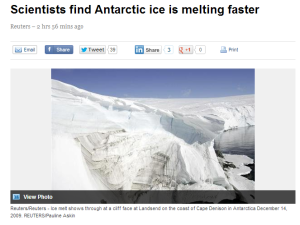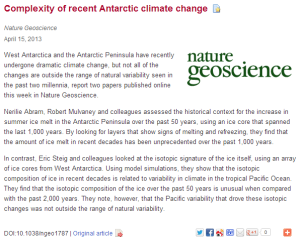
Scientists Show that Global Warming is Destroying Antarctica

We have one of the strongest evidence that global warming is wrecking havoc on Antarctica, as reports Reuters.
Scientists find Antarctic Ice is Melting Faster
CANBERRA (Reuters) - The summer ice melt in parts of Antarctica is at its highest level in 1,000 years, Australian and British researchers reported on Monday, adding new evidence of the impact of global warming on sensitive Antarctic glaciers and ice shelves.
Researchers from the Australian National University and the British Antarctic Survey found data taken from an ice core also shows the summer ice melt has been 10 times more intense over the past 50 years compared with 600 years ago.
“It’s definitely evidence that the climate and the environment is changing in this part of Antarctica,” lead researcher Nerilie Abram said.
Abram and her team drilled a 364-metre (400-yard) deep ice core on James Ross Island, near the northern tip of the Antarctic Peninsula, to measure historical temperatures and compare them with summer ice melt levels in the area.
……
“Once your climate is at that level where it is starting to go above zero degrees, the amount of melt that will happen is very sensitive to any further increase in temperature you may have,” Abram said.
Robert Mulvaney, from the British Antarctic Survey, said the stronger ice melts are likely responsible for faster glacier ice loss and some of the dramatic collapses from the Antarctic ice shelf over the past 50 years.
Their research was published in the Nature Geoscience journal.
Ladies and Gentlemen, you got belatedly April fooled by Reuters, because Nature Geoscience itself provides a different summary.

Complexity of recent Antarctic climate change
Nature Geoscience
April 15, 2013
West Antarctica and the Antarctic Peninsula have recently undergone dramatic climate change, but not all of the changes are outside the range of natural variability seen in the past two millennia, report two papers published online this week in Nature Geoscience.
Nerilie Abram, Robert Mulvaney and colleagues assessed the historical context for the increase in summer ice melt in the Antarctic Peninsula over the past 50 years, using an ice core that spanned the last 1,000 years. By looking for layers that show signs of melting and refreezing, they find that the amount of ice melt in recent decades has been unprecedented over the past 1,000 years.
In contrast, Eric Steig and colleagues looked at the isotopic signature of the ice itself, using an array of ice cores from West Antarctica. Using model simulations, they show that the isotopic composition of ice in recent decades is related to variability in climate in the tropical Pacific Ocean. They find that the isotopic composition of the ice over the past 50 years is unusual when compared with the past 2,000 years. They note, however, that the Pacific variability that drove these isotopic changes was not outside the range of natural variability.
We are sure some readers will describe us as white male republicans or white female ex-governor of Alaska for pointing out this minor inconsistency.
-————————————-
Hyperbole aside, let us take a look at the actual papers to see what is being reported. First paper is from Nerilie J. Abram et al.
Acceleration of snow melt in an Antarctic Peninsula ice core during the twentieth century
Over the past 50 years, warming of the Antarctic Peninsula has been accompanied by accelerating glacier mass loss and the retreat and collapse of ice shelves. A key driver of ice loss is summer melting; however, it is not usually possible to specifically reconstruct the summer conditions that are critical for determining ice melt in Antarctic. Here we reconstruct changes in ice-melt intensity and mean temperature on the northern Antarctic Peninsula since AD 1000 based on the identification of visible melt layers in the James Ross Island ice core and local mean annual temperature estimates from the deuterium content of the ice. During the past millennium, the coolest conditions and lowest melt occurred from about AD 1410 to 1460, when mean temperature was 1.6?C lower than that of 19812000. Since the late 1400s, there has been a nearly tenfold increase in melt intensity from 0.5 to 4.9%. The warming has occurred in progressive phases since about AD 1460, but intensification of melt is nonlinear, and has largely occurred since the mid- twentieth century. Summer melting is now at a level that is unprecedented over the past 1,000 years. We conclude that ice on the Antarctic Peninsula is now particularly susceptible to rapid increases in melting and loss in response to relatively small increases in mean temperature.
Second paper is from Eric Steig et al.
Recent climate and ice-sheet changes in West Antarctica compared with the past 2,000 years
Changes in atmospheric circulation over the past five decades have enhanced the wind-driven inflow of warm ocean water onto the Antarctic continental shelf, where it melts ice shelves from below1, 2, 3. Atmospheric circulation changes have also caused rapid warming4 over the West Antarctic Ice Sheet, and contributed to declining sea-ice cover in the adjacent AmundsenBellingshausen seas5. It is unknown whether these changes are part of a longer-term trend. Here, we use water-isotope (?18O) data from an array of ice-core records to place recent West Antarctic climate changes in the context of the past two millennia. We find that the ?18O of West Antarctic precipitation has increased significantly in the past 50 years, in parallel with the trend in temperature, and was probably more elevated during the 1990s than at any other time during the past 200 years. However, ?18O anomalies comparable to those of recent decades occur about 1% of the time over the past 2,000 years. General circulation model simulations suggest that recent trends in ?18O and climate in West Antarctica cannot be distinguished from decadal variability that originates in the tropics. We conclude that the uncertain trajectory of tropical climate variability represents a significant source of uncertainty in projections of West Antarctic climate and ice-sheet change.
This blog post nicely summarizes what Eric Steig is saying.
Lead author of the study Eric Steig from the University of Washington identified that the majority of Antarctic warming came during the 1990s in response to El Nio conditions in the tropical Pacific Ocean. The researchers suggest the changes in the 1990s was similar to changes in other decades with temperature spikes and identified the 1830s and 1940s.
“If we could look back at this region of Antarctica in the 1940s and 1830s, we would find that the regional climate would look a lot like it does today, and I think we also would find the glaciers retreating much as they are today,” said Steig in a media release.
We will not mind if it is eventually found through scientific work that Antarctic warming is indeed unprecedented rather than unusual. Neither will we mind, if it is shown through proper research that human genome is 80% functional. Our complaint is about sensational and misleading reporting of science.
-——————————
Antarctica Cooling Controversy
The wikipedia article on Antarctica discusses why ‘cooling controversy’ mentioned by Michael Crichton is not a controversy. We have not studied the original papers to comment further.